Polish autonomy, Polish courts, schools, universities, newspapers and books, Polish theater and industry. Where? In the Soviet Union. When? Just before Stalin decided to condemn all Poles to death.
In 1921, a new national policy was adopted in Bolshevik Russia, thanks to which all nations living in the Soviet Union gained the right to develop their culture. Lenin, of course, did not do it out of good heart. The aim was to appease a country torn apart by civil war and to strengthen party power. And the dragging of minorities graciously endowed with autonomy to the Bolshevik side.
Polish socialist "paradise"
The new policy assumed the creation of territorially compact autonomous republics, autonomous regions and national rural councils. As part of it, on July 21, 1926 in Volhynia, the so-called Marchlewszczyzna, or Polish National Region. Julian Marchlewski with its capital in tiny Dołbysz (renamed Marchlewsk from 1927). This formation included 96 villages and towns, and 40% of its territory was swamps, sands and forests. Its population was 40,500 inhabitants, including 70% Poles.
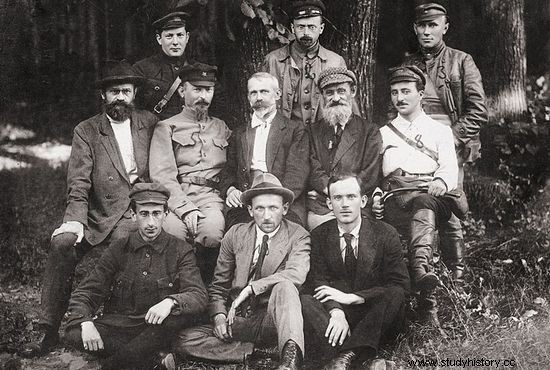
Julian Marchlewski (sitting in the center) was a distinguished Bolshevik. It was he who headed the Polrewkom when the Red Army attacked Poland in 1920. No wonder then that he became the patron of the first Polish National Region.
The region was supposed to show the superiority of the Soviet Union over its capitalist Polish neighbor, so it was generously subsidized:80-90% of its budget came from the central budget . In Marchlewsk alone, a power plant, a hospital, a Polish seven-year school, a post office, a pharmacy, a cinema theater, a veterinary clinic and residential buildings for administrative and party officials were erected. The telephone network was also expanded and a regular bus connection with Żytomierz, approx. 120 km away, was launched.
In order to create the complete structure of a socialist society in Marchlewszczyzna, an investment was made in industry. Two new glassworks were built and two old ones were modernized. However, as it happens in a centrally controlled economy, the high specialization of production and the lack of a railway line meant that the products of Polish workers were often not needed by anyone. But it was not Stalin's point of profitable production.
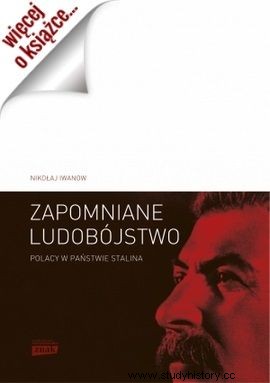
In spite of the fascists
In Belarus, the Polish autonomous region was not established until 1932. The problem was the greater dispersion of the Polish population than in Ukraine, and the Belarusian communists also put up resistance. In their opinion, the Catholics here were actually Polonized Belarusians. And this despite the fact that the interested parties themselves had a completely different opinion on this subject. In the early 1930s, local party activists were, however, accused of bourgeois nationalism and cooperation with Polish fascism by spreading national discord. They had to step down.
Located on the border with Poland, the Kojdanowski district was transformed into the Polish National Region and was given the name of Feliks Dzerzhinsky in the same year. That "Dzerzhinsk region" consisted of seventeen village councils, including nine Polish. Formerly, these were Belarusian councils. Their inhabitants heard that although yesterday they were still Belarusians saved from Polonization, today they are to become model Poles.
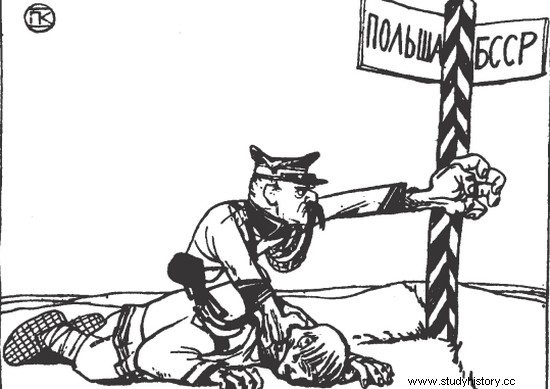
As part of Polish autonomy, the Polish-language press appeared in the Soviet Union. It was a tool of Bolshevik propaganda, which at every step presented the threat from the "fascist" side of the Second Polish Republic. The illustration shows a caricature in one of the issues of "Orka". Illustration from the book by Nikolai Ivanov, Forgotten Genocide. Poles in the state of Stalin. »Polish Operation« 1937–1938 ″ (Znak Horyzont 2015).
Huge funds were also invested in Dzerzhinsk. Administrative buildings, schools and clubs were built. A breeding technical school and a pedagogical school were opened under the pompous name of the Polish Scientific Combine. The activity was started by the Polish Touring Kołchozowo-Sowchozowy Theater. The economic development was supported by the Warsaw-Moscow railway line running through it. Anyone who traveled from the capital of the rotten, bourgeois Republic of Piłsudski to the capital of the state of liberated workers could observe from the windows of the wagon the truest idyll prevailing in a better version of Poland. Or at least that was the theory.
Blossoming Polishness
In Marchlewszczyzna alone, there were 89 Polish schools and 83 Polish reading rooms. 85 illiteracy eradication points were set up, where people were taught to write and read in Polish. It was similar in Dzerzhinsk region. But Polish life developed in other places as well, especially in Leningrad, Minsk and Kiev.
In 1928, there were a total of 577 Polish schools with over 10,000 students in Ukraine. students, while in Belarus 9 thousand were educated in 138 schools. kids. At the turn of the 1920s and 1930s, the number of schools in Belarus almost doubled. In Kiev, there was a university in the form of the Polish Institute of Social Education, and in Minsk, the Polish Scientific Sector of the Academy of Sciences.
Russian historian Nikolai Ivanov sums up in his book Forgotten Genocide. Poles in the state of Stalin. »Polish Operation« 1937–1938 ″:
Never Neither before nor after these events outside the Polish state, Polish school developed as dynamically and on the scale as it was in the framework of the creation of Polish socialist autonomy.
This is not the end. Polish books and newspapers were published in large numbers. Naturally, only those created on the Soviet side of the border. Annually, between 100 and 300 books were published, the total circulation of which exceeded one million copies. Moreover, thirty Polish newspapers were published in Ukraine, and in Belarus six different kinds of Polish newspapers.
Some honey and a barrel of tar
This seemingly glorious national politics contained not even a catch, but a powerful hook on which Polish culture was to hang. The Polish language was to be a tool for the Sovietization of the Polish population, and all cultural ties with "your" and "fascist" Poland were categorically severed. Instead, the intention was to create a "healthy", "proletarian" Polish culture. Poles in the USSR were to be Soviet patriots, not Polish.
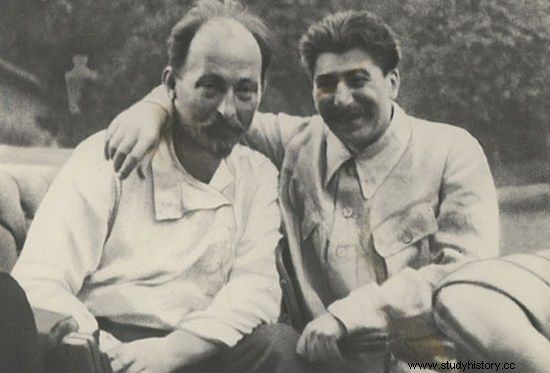
The famous head of the Cheka, Feliks Dzerzhinsky, also became the patron of the Polish National Region. Pictured with Joseph Stalin, who owed him a lot.
The level of education in Polish schools was low, because the teachers were young people from working-peasants' families, educated quickly and superficially in pedagogical techniques. They preserved Polishness in its communist version with truly neo-fiery enthusiasm and conviction. To facilitate "Polonization", it was decided to reform Polish spelling. It was supposed to be more accessible to the peasant-working class masses. And above all, for the authors of communist books and newspapers, who themselves often did not know the speech of Mickiewicz and Słowacki.
This is the dream of many a student: rz, sz, cz, ą, ę and ó were to disappear from the language and be replaced by ż, s, c, om, em and u . The bourgeois class is not bothered by spelling, difficult for a peasant, a worker, a child who does not have as much time to study as yours or a bourgeois (merchant or factory) child - it was argued. The new rules were drawn up in 1933 but were not approved in time.
Under these conditions, "proletarian" culture could not reach a high level. Literature and theater were primitive, steeped in communist ideology and squeezed into the framework of socialist realism. As a consequence, these gifted artists, such as Bruno Jasieński, only became discouraged by the Polish language. Anyway, among the published books, translations of the classics of Marxism-Leninism prevailed anyway.
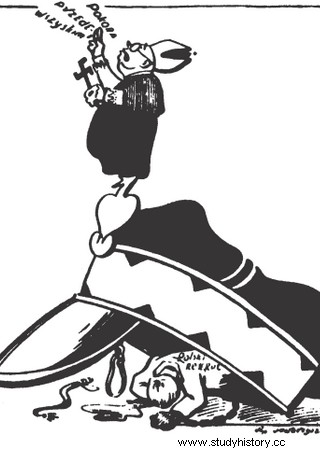
Another example of Polish-language Bolshevik propaganda. This time from "Trybuna Radziecka". Illustration from Nikolai Ivanov's book "The Forgotten Genocide" (Horizon Mark 2015).
All this polonization is aptly assessed in his book by Nikolai Ivanov:
[...] the creation of Polish socialist autonomy in the further Borderlands logically fits into the entire system of building the Stalinist totalitarian system. The communist party, by setting a specific direction for the creation of Polish autonomy, clearly limited the freedom of action of Polish architects of this autonomy.
Soon there was no question of any autonomy. In the second half of the 1930s, Polish autonomous regions, institutions and schools were liquidated. Even in 1932, fighting Polishness meant favoring fascism. Four years later, being Polish meant taking part in a fascist conspiracy. Crime punishable by death…
Source:
Nikolai Ivanov, Forgotten genocide. Poles in the state of Stalin. "Polish operation" 1937–1938 , Horizon 2015 Mark.
